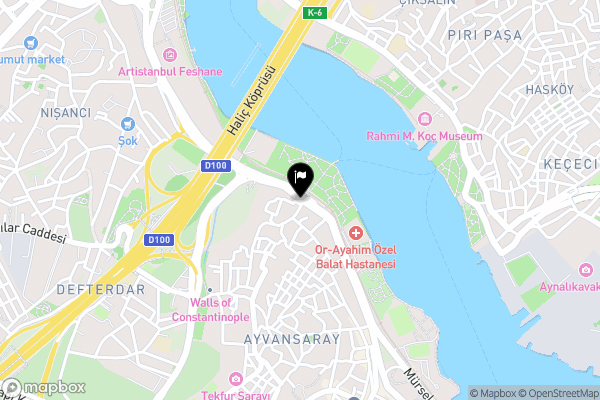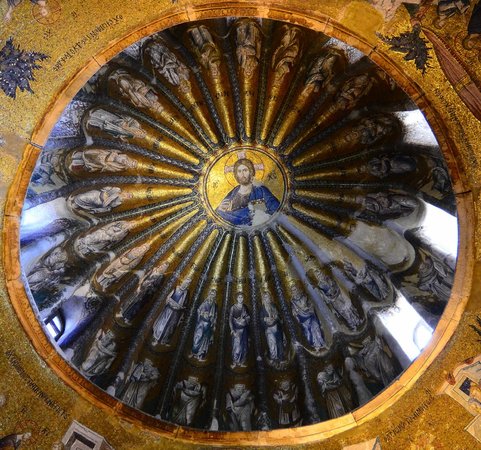Vlaherna Meryem Ana Church
52Istanbul, TurkiyeDetails
Reviews
 52
52
S4275FNmoniqued One of my favorite places in Istanbul! Little Greek orthodox church with a beautiful garden. There is a source of holy water within the church, don't hesitate to take a bottle with you.

ctsounis Visiting the historical Church of St. Mary of Blachernae or Panagia Blachernae Church in Constantinople (Istanbul) known to Greeks made history more alive. Traveling with a middleclass Tripolis travel group projected the positive Greek point of view of Byzantium in August 2019. The Akathist hymn to the Defender General Panagia Mary is sung on 5 Fridays of Lent. The name means everyone stands in reverence during the service. Historically, it is taught in Greek education as a Victory hymn thanks for protecting Constantinople from the Avars (Asian invaders). The miracle of the city is a historical fact. The Church is a shadow of its Byzantine glory. Built in 1867 by the Greek Orthodox furriers, it encloses the holy spring. Bottles were at the spring for all to take, without asking for a donation. This piety and lack of commercialism was present in other Greek Orthodox churches in Istanbul.

deanc706 I was advised to visit this small church by a good friend, who had been to Istanbul many times. I can't thank him enough!!! We had our days filled with the normal sites...but made time to come to this little church. For Orthodox, you may or may not know, this is THE CHURCH where the Byzantine people and patriarch came down to..and sang the Akathist Hymn (Ti Ipermaho in Greek) for the very first time. The story of that hymn is amazing in itself. Suffice to say the patriarch had taken the Icon painted by St Luke around the walls of the City, to ward off a joint Persian/Avar attack (while the Emperor Heraclius was away with the army). We are talking about roughly 600 AD. A storm came up, and destroyed the Avar fleet (there is an icon depicting this in the church). When the people and patriarch finished the procession, they came down to this little church (actually, another building but in the exact same spot) and prayed all night "standing" (akathist means "standing in Greek) to give thanks to the Theotokos for saving them. This little church is an oasis from the hustle bustle of the 10 million person megalopolis of Istanbul. We walked in, and were able to RELAX!!! The wonderful priest gave us some holy water, as he showed us around the interior. What a wonderful, peaceful and sacred place. This is the FIRST place I am going the next time I am in Istanbul!!! We all LOVED it!

BillyV813 We visited this Church of the Virgen Mary which is a functioning greek orthodox church. It is a small church with a spring which they bottle and you can bring home. You can make a small donation to cover their costs for the plastic bottles. A must visit if you are a Virgen Mother devotee.

carolas936 Panagia Vlaherna Meryem Ana Church (a.k.a. Saint Mary of Blachernae) is located in Ayvansaray neighborhood, near the northern corner of the (much older) Theodosian walls and close to the shore of the Golden Horn. The church sets back from the street, inside a pleasant walled garden. The current church, built in 1867 is on the site of a fifth century Byzantine shrine commissioned Empress Aelia Pulcheria in 450, sited near a fountain of holy water. Emperor Leo I added a holy reliquary (Ayía Sorós) to contain the holy mantle and robe of the Virgin brought from Palestine in 473, and also a sacred bath (Ayion Loúsma) enclosing the fountain. The church was a basilica divided into three aisles by two colonnades. It had a famous icon of the Virgin painted on wood and revetted with gold and silver, called Blachernítissa (after the church). This icon and the relics of the Virgin were considered by the Byzantines as powerful sacred objects, able to ward off disaster. In 626, during the siege of Constantinople by the combined armies of the Avars and the Persians, Blachernitissa was paraded along the ramparts; some time later the fleet of the Avars was destroyed. The protection of the Virgin of the Blachernae was also credited with the Byzantine victories during the Arab siege of 717-718, and the destruction of the Rus fleet in 860. During the seige of Constantinople by the Saracens (Muslims) in 910, people gathered for an all-night vigil in the church of Blachernae. The Virgin Mary was spotted walking in the air; she covered the faithful with her veil and the Saracens retreated. Saint Mary of Blachernae was completely destroyed by fire in 1070, but was quickly rebuilt by Byzantine emperors Romanos IV Diogenes and Michael VII Doukas. The robe of the Virgin Mary disappeared during the sack of Constantinople by the crusaders in 1204. The icon Blachernítissa was lost in 1434 when a fire started in the church and spread to the surrounding neighborhood. The area was largely neglected during the Ottoman period. In 1867, the Guild of the Orthodox furriers bought the parcel around the holy fountain, and built a small church. It has a trapezoidal plan with sloping roof, and is adorned with icons and frescoes; the iconstasis is small, but well done. Visitors can fill bottles from the holy fountain, which is believed to have healing powers. Pilgrims can also ritually wash their eyes at a line of faucets in the sacred bath. Saint Mary of Blachernae is open from 9 am to 5 pm every day, with no admission fee (although a donation is greatly appreciated). The garden is a quiet place to relax away from the street noise.
How to get there

Similar places
 Rahmi M. Koc Museum1,612Cultural, Historical, Recreational, Nature
Rahmi M. Koc Museum1,612Cultural, Historical, Recreational, Nature Chora Museum5,995Cultural, Historical, Recreational, Nature
Chora Museum5,995Cultural, Historical, Recreational, Nature Eyup218Cultural, Historical, Recreational, Nature
Eyup218Cultural, Historical, Recreational, Nature Bulgarian Orthodox Church106Cultural, Historical, Recreational, Nature
Bulgarian Orthodox Church106Cultural, Historical, Recreational, Nature Balat432Cultural, Historical, Recreational, Nature
Balat432Cultural, Historical, Recreational, Nature Mihrimah Sultan Camii381Cultural, Historical, Recreational, Nature
Mihrimah Sultan Camii381Cultural, Historical, Recreational, Nature Eyup Sultan Mosque1,853Cultural, Historical, Recreational, Nature
Eyup Sultan Mosque1,853Cultural, Historical, Recreational, Nature Cathedral Church of St George72Cultural, Historical, Recreational, Nature
Cathedral Church of St George72Cultural, Historical, Recreational, Nature Pierre Loti Tepesi1,180Cultural, Historical, Recreational, Nature
Pierre Loti Tepesi1,180Cultural, Historical, Recreational, Nature Miniaturk1,730Cultural, Historical, Recreational, Nature
Miniaturk1,730Cultural, Historical, Recreational, Nature



